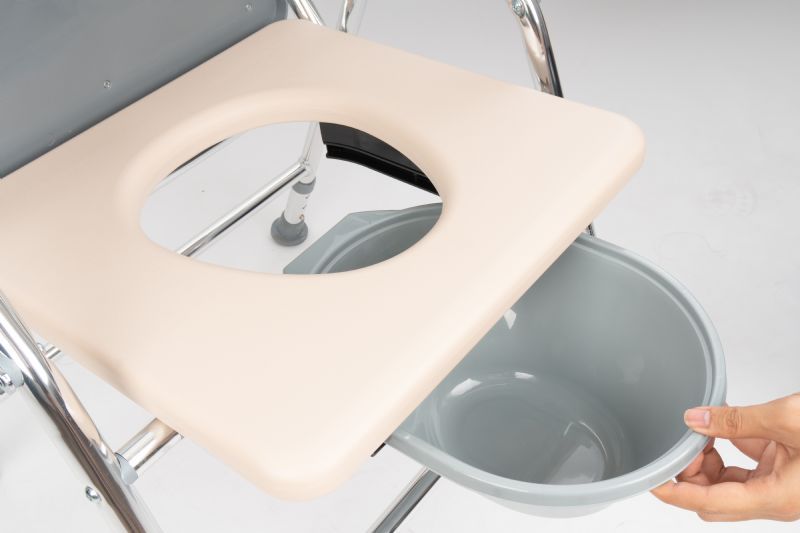 Written by Mike Price, OT
Written by Mike Price, OT
Welcome to your introduction to bedside commodes. Bedside commodes are useful tools for anyone who spends a lot of time in bed and is unsteady on their feet. Independently managing toileting without having to walk to the bathroom greatly reduces the risk of a fall as well as dependence on a caregiver.
For more helpful information that will assist you in choosing a bedside commode, we have a more comprehensive guide titled: How to Choose the Best Bedside Commode.

In our experience, people who need a bedside commode are often weak or struggling with balance, the stability of a commode is a significant factor to consider. Rubber-tipped feet or locking casters to keep it in place, handrails for leverage and stability, and droppable armrests to facilitate transfers all add to the safety and stability of a bedside commode.
Bedside commode seat height from the floor ranges from 17 inches to 28 inches, seat widths range from 13 inches to 31 inches, seat depths range from 14 inches to 23 inches, and widths between armrests range from 17 ¾ inches to 31 ¼ inches. Many models have height-adjustable legs, and this is especially important if you are going to place it over your toilet, as the toilet height has to be accommodated.
The weight capacity for a standard bedside commode is 300 pounds, with bariatric models able to accommodate users weighing up to 1,000 pounds.
In our experience, bedside commode frames come in aluminum, stainless steel, or healthcare-grade PVC. They are designed to be lightweight, durable, and strong. Some of the seats are vinyl, while the frames made of aluminum weigh the least, stainless steel frames are the most stain-resistant while being extra strong, and we know PVC plastic frames are the easiest to keep clean.

A bedside commode looks like a chair or a bench and is set up near a bed. We’ve also known these as portable toilets, toilet chairs, or commode chairs. Bedside commodes have a seat similar to a toilet seat and have a detachable basin under the seat that collects urine and feces and is emptied after use.
People who are recovering from an injury or surgery, who have permanent mobility challenges, or who need help getting to the bathroom promptly can all benefit from easier and safer toileting provided by a bedside commode.
A 3-in-1 bedside commode is used as a bedside commode, a toilet safety frame that can be used on a standard toilet for balance and leverage while using the bathroom, and a shower chair for safe bathing.
Using your walker, back up to the bedside commode until you feel it behind your knees. With both hands, reach back to the rails on the bedside commode then slowly lower yourself onto the seat. When you’re finished, push up from the rails or seat, and stand. Make sure you get your balance before reaching for your walker, and when you have your walker in hand, proceed away from the commode.


We rank the GentleBoost Uplift 3-in-1 Commode Shower Chair by Platinum Health as the best bedside commode. This versatile piece of equipment simplifies toileting and bathing with its self-powered stand-assist function that facilitates seat entry and exit. This feature also helps users maintain their mobility and independence, with assistance coming from the commode, rather than a caregiver. We love that it can be used as an over-toilet commode, bedside commode, or shower chair.
To review our other top choices, check out our 5 Best Bedside Commodes and Toilet Chairs.
If you’re wondering if a bedside commode will be helpful for you or someone you love, this introduction has hopefully answered your questions about what these devices are and how they can contribute to accomplishing personal toileting activities.
Thank you for taking the time to read about bedside commodes and who they benefit from. Check out the bedside commodes and bathing & toileting products section of our website for more information and product listings.
We invite you to visit Caregiver University for helpful articles created to equip you to confidently make informed purchasing decisions.
>> Shop Bedside Commodes <<
Co-Founder of Rehabmart and an Occupational Therapist since 1993. Mike has spent his professional career working in multiple areas of Occupational Therapy, including pediatrics, geriatrics, hand therapy, ergonomics and inpatient / outpatient rehabilitation. Mike enjoys writing articles that help people solve complex therapeutic problems and make better product choices.